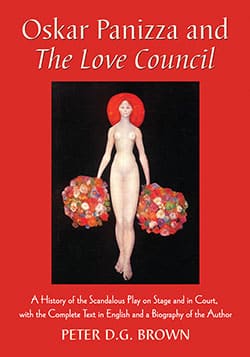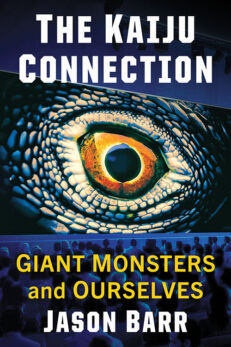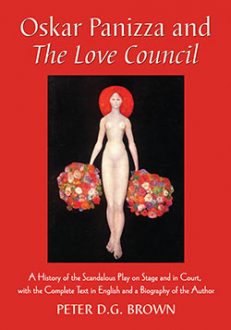Oskar Panizza and The Love Council
A History of the Scandalous Play on Stage and in Court, with the Complete Text in English and a Biography of the Author
$49.95
In stock
About the Book
In 1894, German society was introduced to The Love Council, a scandalous new play by the playwright Oskar Panizza. The carnivalesque satire, dealing with the first recorded outbreak of syphilis in 1495, portrays the scourge as divine punishment for the rampant sexual excesses in the Vatican court of the Pope of the time, the notorious Rodrigo Borgia. Panizza was imprisoned for one year on 93 counts of blasphemy, the harshest sentence ever given to an artist in the Second Empire. This book contains a detailed history of the play on stage and the court proceedings that led to Panizza’s imprisonment. A new English translation of the play is included, as well as a biography of its avant-garde, modernist author.
About the Author(s)
Bibliographic Details
Peter D.G. Brown
Format: softcover (7 x 10)
Pages: 292
Bibliographic Info: 56 photos, chronology, appendices, notes, bibliography, index
Copyright Date: 2010
pISBN: 978-0-7864-4273-7
Imprint: McFarland
Table of Contents
Preface 1
Abbreviations 5
Part I: The Play
1. Oskar Panizza’s Legacy 7
2. The Love Council: A Heavenly Tragedy in Five Acts, 1894 26
3. Additions to the Second and Third Editions, 1896–1897 66
Part II: The Author
4. The Early Decades, 1853–1894 75
5. Downward Spiral, 1895–1921 94
6. Panizza’s Autobiographical Sketch, 1904 119
Part III: The Trials
7. The 1895 Trial in Munich 125
8. Defense and Judgment in the Matter of The Love Council 132
9. Twentieth-Century Trials 145
Part IV: Reception and Performance
10. M. G. Conrad’s Evaluation, 1895 163
11. Critical Responses to The Love Council, 1895–1897 166
12. Performances around the World, 1962–2008 192
Appendix A. Theatrical Productions of Das Liebeskonzil 249
Appendix B. Chronology of Oskar Panizza’s Life 252
Bibliography 257
Index 277
Book Reviews & Awards
“[T]his scandalous play was not just banned time and again, it has also been republished again and again–and translated into foreign languages. A new English translation has now been presented by the renowned Panizza scholar Peter D.G. Brown, who only recently gained prominence with the publication of the facsimile edition of the play’s manuscript. Like the former publication, his translation is welcome in several respects. First of all, Oreste Pucciani’s 1973 translation has been out of print for some time. Brown is the first to have consulted Panizza’s 1893 manuscript of the work. Additionally, the current volume contains all the key material on the play, along with extensive and updated supplemental material on its author, including documents and information regarding the numerous court proceedings initiated against The Love Council, its contemporary and later reception, as well as a performance history. It can only be hoped that this book will find numerous readers in England and especially in the United States, which, as Brown noted with a touch of irony, is a relatively enlightened and advanced country.”—Rolf Löchel, Philipps-Universität, Marburg, Germany, literaturkritik.de; “[This] new English translation of The Love Council, along with contextual materials, is superior to previous English versions because it is the first to be based on the 1893 manuscript of the play. Possessing profound knowledge of his source material, especially of the many linguistic peculiarities and irregularities of the author (apparent, for example, in Panizza’s increasing use of sometimes bizarre orthographical forms), Brown has mastered the difficult task of translating the drama’s text into comprehensible English, and, despite an inevitable degree of standardization, he still manages to preserve many of the characteristics of the original. The volume also includes a fairly detailed biography of the author as well as material on Panizza’s trials and the worldwide reception and stage history of the play (with some photographs). Brown’s edition reveals not only Panizza’s personal eccentricities but also his polemic and artistic energy, which he used to protest manically against obscurantism, the Catholic Church and its followers, opportunism, sexual inhibitions, and a hypocritical bourgeoisie that he saw as concentrated in Munich. The edition also documents Panizza’s attempt to overcome the traditional theatre, which he regarded as obsolete. In ways similar to those of Wedekind and early Brecht, he tried to do so by systematically integrating versatile forms, such as parody, satire, caricature, variety show, cabaret, vaudeville, and commedia dell’arte. Thanks to a skillful selection of texts, Brown manages to trace Panizza’s development from naturalism, the first explicitly modernist literary movement in Europe, to an innovative combination of heterogeneous elements from so-called low and high culture.”—Johannes G. Pankau, Universität Oldenburg, Modern Drama.





